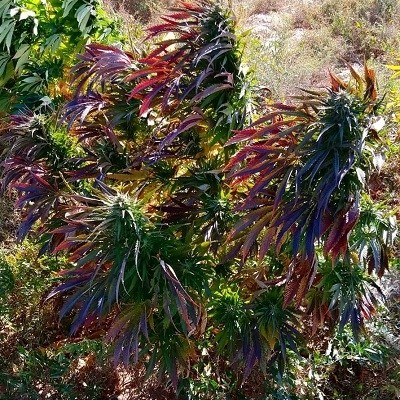
Type : Photoperiod
Sex : Feminized
Flowering Time: From 63 to 77 days
Balochistan's cannabis culture has been one that could be one that could be seen as a legend amongst the legends. Balochistan that is located within Pakistan is also bordered with Afghanistan and Iran on its North-West and West respectively and to ponder the amount of cultural traffic is almost mind boggling. For a number of reasons, the farmers here have a much more progressive thinking in terms of using agricultural practices to gradually improve one's crop and that very often leads them away from shadows of their culture. Last year Indian Landrace Exchange brought everyone Balochistan Selections from Mastung District. This year they have focused towards the desert region of Dasht which is basically a series of mountains, skirts and secluded valleys at the outskirts of Quetta. This particular region at the outskirts of Quetta is extremely dry and features a desert climate with almost no rains through the warmer months of the year, and almost all precipitation comes down in the form of snow during the winters. The temperature remains cool almost throughout the year at the mountains, with snowfall taking place from early November to early December. Balochistan in itself is located only at around 30ºN of the equator without extreme altitudes (not surpassing 4000 meters), so the season length actually allows for the regional landraces to exhibit features that are quintaessential to naturally adapted populations to mid latitude ranges of approx between 24º-32ºN. These populations usually express features that are characteristically marked by medium-long flowering term of 11-13 weeks, which includes a pre flowering stretch of 3-4 weeks before the plants actually go into stage of rapid floral bract production, so eventually plants would finish with 3-4X in size by the time they finish to ripe. However, to everyone's convenience the farmers notoriously import fully domesticated cannabis varieties from higher latitude regions such as Afghanistan and Uzbekistan to amalgamate with their regional landrace strain (as described above) to achieve shorter flowering compact plants that boast an overall higher concentration of cannabinoids and terpenes, which invariably translates in producing a more flavorful and potent hash. As one can understand that selection and maintenance of the crop in traditional cannabis hotspots is done in a crude manner and hence a tremendous amount of diversity can be seen, but only in terms of plant and flower's structure, while smell, high, colors and flowering duration remain consistent to a fair extent. Indian Landrace Exchange chose to work with one of the very skilled farmers from this region who is known for his beautiful purple/red plants and for producing hash of acute effects. With his much needed help, Indian Landrace Exchange made some beautiful purple selections from his garden keeping in mind to still cover full genetic diversity of his farm, so as a result a lot of different types of purple plants is what makes Purple Dasht seed stock to provide a wide angle view of his landrace strain. Quintessential Purple Dasht features: Color: An appreciable amount of plants express lucid colors on leave and floral bracts alike. Colorful undersides of the leaves are one of the typical features of this strain. Smell: The smell takes off an acrid tangent with a number of components such as pine, phenol, fuel, eastern spices and naphthalene with occasional faint floral hints. The smell is also quite intense indicating a high concentration of terpenes. Effects: Purple Dashti imparts a very clear and focused, cerebrally oriented high, which can be utilized and observed as an energetic high, although it builds up gradually in first 15 minutes and then stabiizes for a period of close to 1-2 hours, depending upon the dosage used. The effects in a nutshell are quite social and enjoyable, without causing severe effects such as heart palpitations or paranoia. Structures: In a 10 seed run, there will be plants that would structurally resemble very closely tall narrow leaf varieties or their regional landrace variety. And then there will be plants expressing short compact frame reminiscent of the fully domesticated varieties from higher latitude regions, which have been embedded into their local genepool by gradual introduction and amalgamation. Flowering: Plants will finish flowering within 9-11 weeks regardless of the structure they express.
| Seller |
|---|